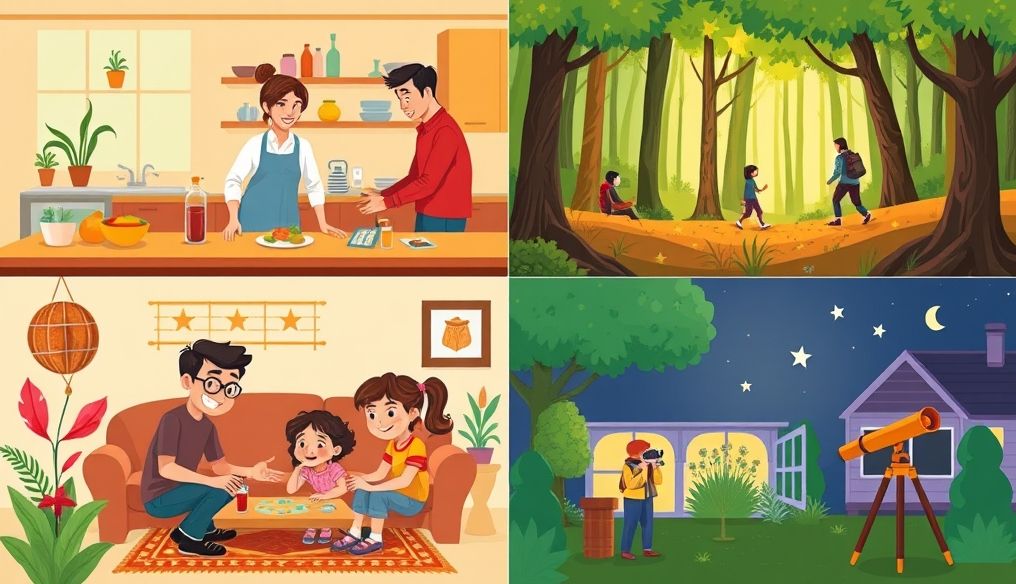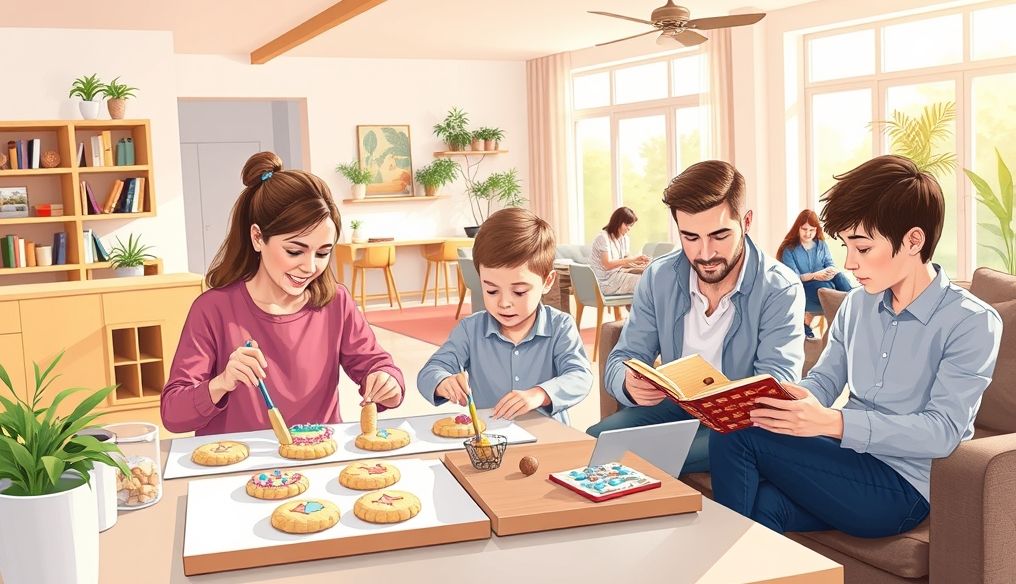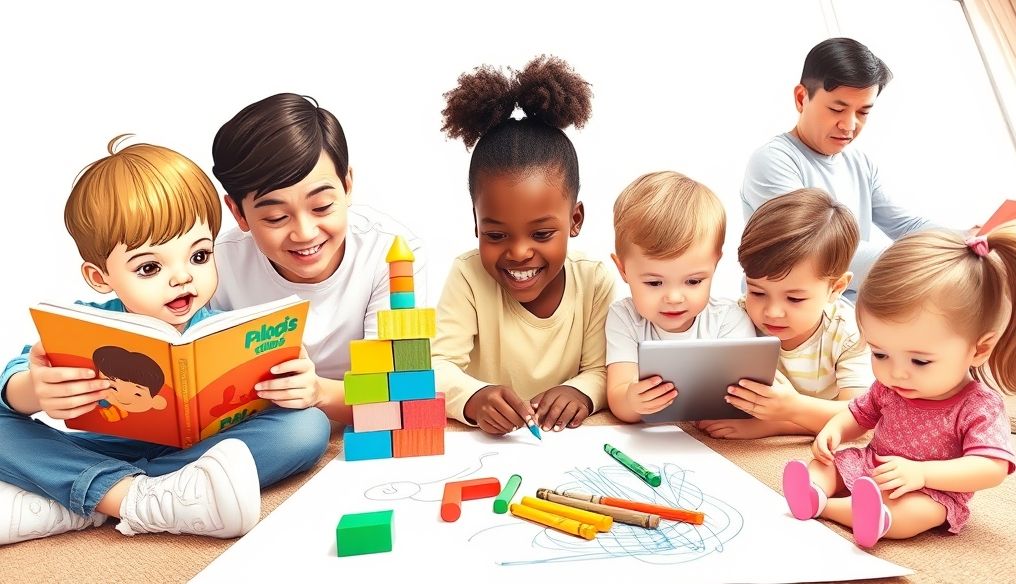The Importance of Family Activities: Building a Happy and Connected Generation
The times we spend with our family are not just fleeting moments, but an investment in our future and the future of our children. Family activities enhance the sense of belonging and security, and contribute to building strong and confident personalities. Let's delve into the benefits of these activities:
- Strengthening Communication: Family activities provide opportunities to talk and listen, strengthening emotional bonds.
- Building Trust: When parents involve their children in their activities, children feel appreciated and respected, which boosts their self-confidence.
- Relieving Stress: Spending quality time with family helps relieve stress and anxiety, and improves the mental health of everyone.
- Creating Unforgettable Memories: The beautiful memories we make with our family stay with us forever, reminding us of the importance of love and mutual support.
- Teaching Values: Through family activities, we can teach our children good values and morals in an indirect and fun way.
Family Health and Fitness Activities: Health for Everyone
Taking care of family health starts with shared activities that promote physical fitness and healthy eating:
- Walking or Running in Nature: Exploring local parks and gardens together.
- Cycling: A fun and beneficial activity for all ages.
- Swimming: A great and refreshing sport, especially in the summer.
- Practicing Yoga or Home Workouts: Many free lessons can be found online.
- Preparing Healthy Meals Together: Teaching children about healthy eating and encouraging them to try new foods.
Additional Tips:
- Make the activities fun and not boring.
- Involve children in choosing activities.
- Be a good role model for your children.
Family Cooking and Kitchen: The Joy of Collaboration and Creativity
Cooking with family is not just about preparing a meal, but an opportunity to learn new skills and spend quality time together:
- Preparing Simple Recipes: Such as pizza or cookies.
- Decorating Cakes or Pies: A creative and fun activity for children.
- Growing Herbs and Vegetables at Home: Teaching children about sustainable agriculture.
- Organizing a Cooking Competition: To add an atmosphere of fun and competition.
Suggested Recipe: Easy Homemade Pizza
- Ingredients: Flour, yeast, water, olive oil, tomato sauce, mozzarella cheese, favorite vegetables.
- Instructions: Mix the dry ingredients, then add water and oil. Knead the dough and let it rise. Roll out the dough and spread with sauce, then add cheese and vegetables. Bake in the oven until golden brown.
DIY Projects and Home Repairs: Learn and Discover Together
DIY projects and home repairs can be fun and educational family activities:
- Making Crafts: Using simple materials such as cardboard, buttons, and yarn.
- Recycling Old Things: Turning empty cans into pen holders or plastic bottles into planters.
- Painting Walls or Furniture: Changing the look of the house and adding a personal touch.
- Repairing Small Things: Such as broken toys or simple electrical appliances.
Basic Tools That Should Be Available in Every Home:
- Screwdriver
- Hammer
- Pliers
- Measuring Tape
- Scissors
Family Travel and Adventures: Exploring the World Together
Traveling is a great opportunity to create unforgettable memories and learn new things:
- Visiting Local Tourist Attractions: Exploring historical and cultural sites near home.
- Camping in Nature: Spending quality time outdoors and learning about wildlife.
- Traveling to Other Cities or Countries: Discovering new cultures and different experiences.
- Visiting Museums and Art Galleries: Learning about history, art, and culture.
Tips for Planning a Successful Family Trip:
- Plan the trip in advance.
- Set a specific budget.
- Involve children in planning.
- Be prepared for unexpected changes.
Technology and Smart Devices: Smart and Responsible Use
Technology can be a great tool for learning and entertainment, but it should be used carefully and responsibly:
- Watching Educational Documentaries: Learning about science, history, and nature.
- Playing Educational Games: Developing cognitive and creative skills.
- Learning New Languages: Using educational apps and websites.
- Creating Family Videos or Blogs: Expressing creativity and sharing experiences.
Tips for Using Technology Responsibly:
- Set time limits for using electronic devices.
- Encourage physical and social activities.
- Monitor the content that children watch.
- Talk to your children about the dangers of the internet.
Family Arts and Culture: Developing Creativity and Artistic Taste
Arts and culture play an important role in developing creativity and artistic taste in children:
- Visiting Museums and Art Galleries: Learning about art, history, and culture.
- Attending Theater and Musical Performances: Experiencing live arts.
- Drawing, Painting, and Sculpting: Expressing creativity and emotions.
- Reading Books and Poetry: Expanding imagination and knowledge.
Tips for Encouraging Artistic Creativity in Children:
- Provide them with art tools and materials.
- Encourage them to experiment and explore.
- Don't criticize their artwork.
- Display their artwork in the home.
Family Nature and Environment: Appreciating and Protecting Our World
Teaching children about nature and the environment helps them appreciate and protect our world:
- Visiting National Parks and Gardens: Exploring nature and learning about plants and animals.
- Planting Trees and Plants: Contributing to environmental protection.
- Cleaning Beaches and Forests: Participating in maintaining the cleanliness of the environment.
- Recycling: Reducing waste and protecting natural resources.
Tips for Teaching Children About the Environment:
- Be a good role model for your children.
- Explain to them the importance of protecting the environment.
- Participate in local environmental activities.
- Make learning about the environment fun and engaging.
Parenthood and Family: Building Strong and Healthy Relationships
Parenthood is a continuous journey of learning and growth:
- Spending Quality Time with Children: Playing, reading, talking, and listening.
- Providing Emotional Support: Helping children cope with difficult emotions.
- Setting Boundaries and Rules: Teaching children about responsibility and discipline.
- Celebrating Achievements: Encouraging children to achieve their goals.
Tips for Building Strong and Healthy Relationships with Children:
- Be emotionally present.
- Listen to your children attentively.
- Respect their opinions and feelings.
- Be patient and understanding.
In conclusion, family activities are a valuable investment in our future and the future of our children. Dedicate time to shared activities, and you will notice the difference in the strength of family bonds and the happiness of its members.




